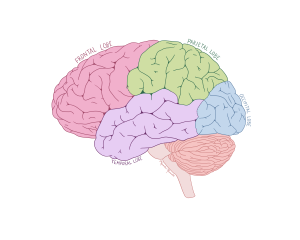44 Cerebrum
What is the cerebrum?
Branching out from the diencephalon, we arrive at the cerebrum, the largest part of the brain. The cerebrum is the area that most people picture when they think of the brain. It’s divided into two halves (hemispheres) and covered by the cerebral cortex, the brain’s outer layer. The cortex is where thinking, sensing, and decision-making happen. This is like the main floor of a busy control centre where plans are made and actions are coordinated.
The cerebrum is organized into four main lobes, each with its own job:

Figure 98 The lobes of the brain; frontal (pink); parietal (green); temporal (purple); occipital (blue)
- Frontal lobe: Located at the front of the brain. This is the “planning room” of the brain. It helps with decision-making, problem-solving, and controlling emotions. It also includes the primary motor cortex, which sends signals to your muscles so you can move with purpose, like choosing to wave or walk. Without this area, we’d act on impulse and have trouble moving with intention.
- Parietal lobe: Found behind the frontal lobe, this is the brain’s “touch and map room.” It helps process information from your skin, like pressure and temperature, and tells you where your body parts are in space (even with your eyes closed). Inside this lobe is the primary somatosensory cortex, which receives and maps out all this sensory information, kind of like putting pins on a map to track where feelings are coming from.
- Occipital lobe: Located at the very back of the brain, this is the “vision room.” It takes in raw information from your eyes and turns it into a clear picture of what you’re seeing. Without it your brain wouldn’t understand what your eyes are looking at.
- Temporal lobe: Found on the sides of the brain near your ears, this is the “sound and memory room.” It helps make sense of sounds, understand language, and store memories. Deep inside it is the hippocampus, which is especially important for creating new memories.
Each of these lobes work together to help you experience the world and respond to it. Sensory signals from your spinal cord ascend, get sorted and understood, and then your brain plans and carries out a response. Whether you’re remembering a song, recognizing a face, or reaching for a snack, the lobes of the cerebrum are all doing their part.

